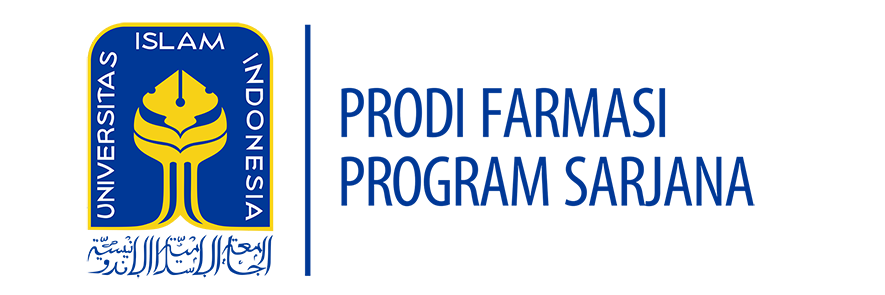COURSE INFORMATION
| Module Name | Basic Concepts of Therapy | |||
| Module Level, if applicable | 2nd year | Types of teaching and learning | Lecture & Interprofessional Education (IPE) | |
| Code, if applicable | SFA-440 | Class size | 50 & 50 | |
| Semester | 4th (Fourth) | Attendance time (hours per week per semester) | 3 h | |
| Person responsible for the module | Dr. Apt. Vitarani Dwi Ananda Ningrum, M.Si | Forms of active participation | Discussion & Report | |
| Lecturer(s) | Dr. Apt. Vitarani Dwi Ananda Ningrum, M.Si
apt. Yosi Febrianti, MSc. apt. Ndaru Setyaningrum, MSc. |
Workload | Lecture: 2 (hour) x 14 (meeting) = 28
Preparation and follow up 4 (hour) x 14 (self-learning) = 56 Attendance time 1 (hour) x 12 (meeting) = 12 Preparation and follow up 4 (hour) x 14 (self-learning) = 24 |
|
| Language | English- Indonesia | Total workload | 120 hours | |
| Relation to curriculum | Compulsory course | Credit points | 3 CU | |
REQUIREMENTS
| Requirements according to examination regulations | Minimum attendance at lectures is 75% (according to UII regulation). Final score is evaluated based on assignment and reports (40%), mid semester exam (30%), and end semester exam (30%). |
| Recommended prerequisites | Pharmacology |
| Related course | – |
| Study and examination requirements and forms of examination | Mid-term, Final term, and Presentation. |
MODULE OBJECTIVES/INTENDED LEARNING
By the end of this course students should be able to:
- Understand the role of pharmacist in different scopes of pharmaceutical work in science and technology as well as pharmaceutical care
- Understand the role of pharmacists and that of other healthcare workers as part of a health professional team in healthcare facilities
- Explain the definition, aims, medication-related issues, and impacts of irrational drug use, as well as the risk factors in patients with the high potential for irrational drug use.
- Explain the pharmacokinetic-pharmacodynamic changes of drugs in a specific population based on the physiological approach (pediatrics, geriatrics, pregnant women, breastfeeding mothers) and pathological approach (obesity-malnutrition, renal function disorders, liver function disorders) AND analyze their correlation with the principles of drug use.
- Explain the pharmacokinetic-pharmacodynamic changes of drugs in a specific population based on the physiological approach (pediatrics, geriatrics, pregnant women, breastfeeding mothers) AND analyze their correlation with the principles of drug use.
- Explain the pharmacokinetic-pharmacodynamic changes of drugs in a specific population based on the pathological approach (obesity-malnutrition, renal function disorders, liver function disorders) AND analyze their correlation with the principles of drug use.
- Describe the types of ADR and their examples and distinguish the types and mechanisms of drug interactions as well as the principles of ADR and drug interactions prevention and management AND correlate them with the risk factors for the occurrence of ADR and clinically-relevant drug interactions.
- Describe the types of ADR and their examples as well as the principles of ADR prevention and management.
- Distinguish the SOAP method used by healthcare workers in integrated services for patients in healthcare facilities and classify data and information in a scenario of inpatients with a CHRONIC disease into S, O, A, and P parts from a pharmaceutical-care perspective AND use the SOAP method for patients with a disease in primary healthcare facilities.
- Apply the SOAP method in a case of patient with hypertension in primary healthcare facilities
CONTENT
This course is designed for discussing the concept of drug therapy. It will cover knowledge about the role of pharmacists and that of other healthcare workers as part of a health professional team in healthcare facilities, rational therapy, the pharmacokinetic-pharmacodynamic changes of drugs in a specific population based on the physiological approach, ADR, and SOAP method
MEDIA EMPLOYED
Text books, slides (power points), and video
READING LISTS
- Robert J. Cipolle, Linda M. Strand, Peter C. Morley , Pharmaceutical Care Practice: The Patient-Centered Approach to Medication Management Services, 3e, 2012, McGraw-Hill Medical
- Dipiro, JT., Talbert, RL., Yee., et al., 2017, Pharmacotherapy: Pathophysiologic approach, Pediatrics, 10th, Mc-Grawn-Hill
- Dipiro, JT., Talbert, RL., Yee., et al., 2017, Pharmacotherapy: Pathophysiologic approach, Geriatrics, 10th, Mc-Grawn-Hill
- Journal websites (www.nejm.org ; www.bmj.com journal ; www.cochrane.org; https://ebm.bmj.com/)
- Kemenkes RI (Indonesian Ministry of Health), 2011, Modul Penggunaan Obat Rasional (Rational Drug Use Module)
- WHO, 2002, Promoting rational use of medicines: core components
- Royal Pharmaceutical Society, 2016, Stockley’s Drug Interaction, Pharmaceutical Press
- Portofolio Pelayanan farmasi klinik PKPA Puskesmas PSPA UII (Portfolio of Clinical Pharmacy Services)
- http://perpustakaan.farmalkes.kemkes.go.id/uploaded_files/temporary/DigitalCollection/ZjhmMWQ2OWNiYmZjOWFiYzA0NDdiZGJhNWYzMmNmZWUxMzZiMDMxYw==.pdf
- https://www.google.com/urlsa=i&url=http%3A%2F%2Ffarmalkes.kemkes.go.id%2Fv2%2F%3Fp%3D5387&psig=AOvVaw2nRvNuwryTFiTRtikt&ust=1580962952130000&source=images&cd
=vfe&ved=2ahUKEwjeqMuKyLnnAhWt4TgGHaXwAzwQr4kDegUIARDSAQ - Al-Qur’an and Al-Hadith
